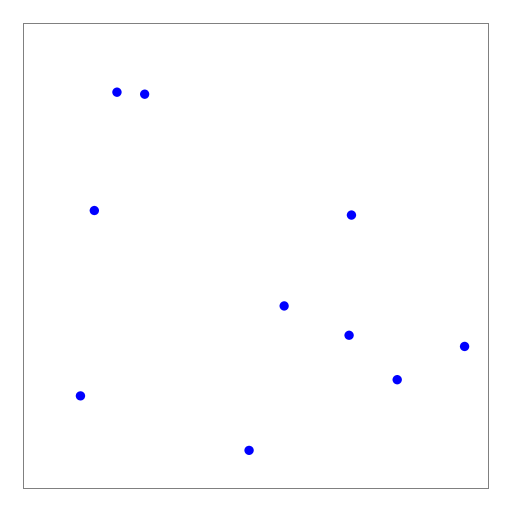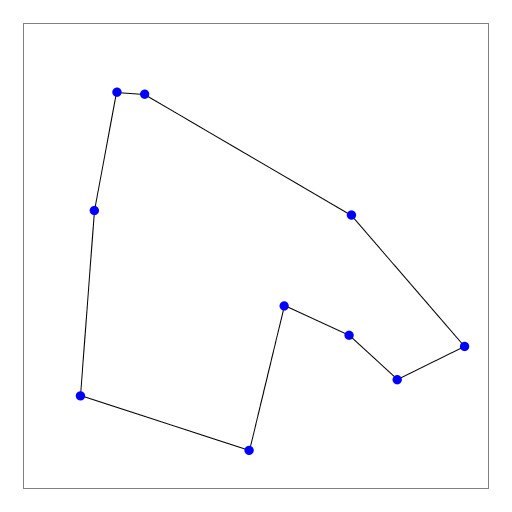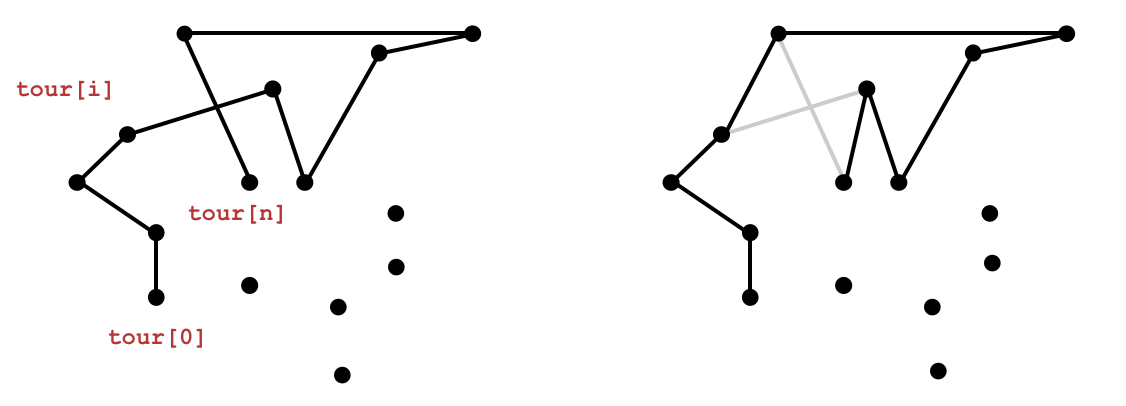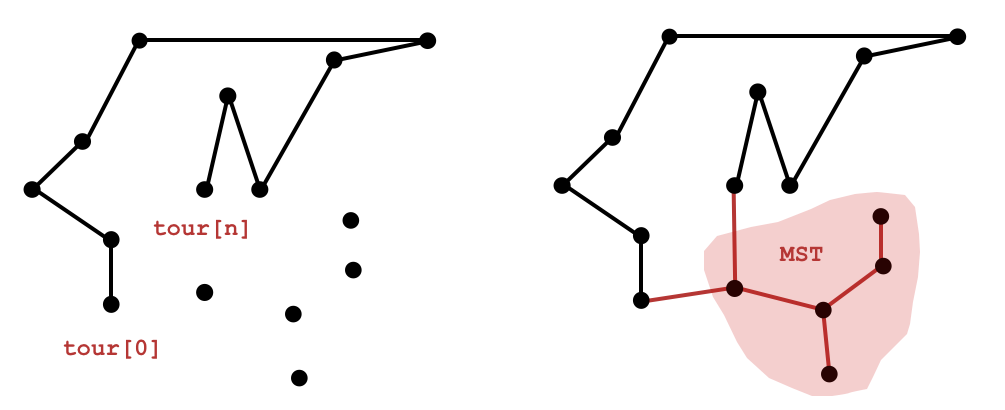COS 226 Programming Assignment
Backtracking for the TSP
Write a program that finds the exact solution to the
Euclidean traveling salesperson problem:
Given N points in the plane, find the shortest tour
that visits all of the points and returns back home.
The goal of this assignment is to develop respect for intractability
and to introduce you to the idea of using backtracking to substantially
reduce the amount of computation required to solve typical inputs
of an intractable problem.
Starting point.
Your first task is to write a program that tries all possible tours and
keeps track of the best one.
Start with the permutation-generation program
Rooks.java
from lecture and
Point.java
(which you have used before). Rename
the permutation-generation program TSPbrute.java and
make the following changes:
- Replace the instance variable int[] rooks with
Point[] tour to hold the current partial tour.
- Add an instance variable Point[] best to hold the best
tour seen so far.
- Change the constructor to take a Point array as argument.
- Change the process() method to
copy tour[] into best[]
if it represents a shorter tour and to draw the
improved tour on standard draw.
You will need various code (to initialize the instance
variables, compute tour lengths, and so forth) to complete this part of
the assignment.
Also, write a main() driver to read from standard input
an integer N followed by the N points (two double values per line).
For the input file tsp10.txt, your program should
output the following optimal tour (in exactly the format specified):
% more tsp10.txt
10
0.70501 0.58793
0.26077 0.84765
0.12284 0.19949
0.20125 0.85198
0.48505 0.08244
0.94810 0.30570
0.69991 0.32967
0.15261 0.59770
0.56046 0.39271
0.80336 0.23430
|
|
% java TSPbrute < tsp10.txt
10
0.70501 0.58793
0.94810 0.30570
0.80336 0.23430
0.69991 0.32967
0.56046 0.39271
0.48505 0.08244
0.12284 0.19949
0.15261 0.59770
0.20125 0.85198
0.26077 0.84765
Distance = 2.7600550582605496
|

|
|

|
Estimate the running time.
Of course, TSPbrute.java is prohibitively
slow even for small N, because its running time is proportional to
about N! (N factorial).
Your next task is to answer the following two questions (and justify
your answers):
- What is the largest value of N for which you
can find the optimal tour in 1 minute?
(Assume that the points are random points in the unit square.)
-
What is the largest value of N
for which your program would find the optimal tour if it could run for
1 million centuries?
Answer these two questions for each successive (cumulative) improvement
that you implement in this assignment (and justify your answers).
Backtracking (by pruning with a lower bound).
Your next task is to implement a simple backtracking test: if the length
of the current path (from tour[0] to tour[n])
plus the distance connecting the two endpoints
is greater than or equal to the length of the best tour seen so far,
then backtrack. You can
use Queens.java
from lecture as a model: you need only implement
a backtrack() method that does the job.
Be sure that you get the optimal tour for
the small input files that you can check, then answer the two standard
questions.
Initial tour.
To improve the performance of the backtracking test, implement the
farthest insertion heuristic compute a decent initial tour.
- Start with the two points that are farthest apart,
and repeat the following steps until N points are on the tour.
- Among all points not in the tour, find the one that is the
farthest from the nearest point already in the tour.
(That is, for each point not on the tour, compute the Euclidean
distance between it and every point on the tour. Its distance to the
tour is the minimum such distance. The point to add is the one
the has maximum distance to the tour.)
- Insert that point into the
tour in the position where it causes the smallest increase in the tour length.
Begin the backtracking algorithm with the resulting permutation.
This provides a better initial lower bound; it also provides a more
favorable ordering of the points.
Be sure that you get the optimal tour for
the small input files that you can check, then answer the two standard
questions.
Backtracking (by edge exchange).
Next, add to your backtrack() method an
edge exchange test: if
there is an edge (tour[i] to tour[i+1]) on the
current path such that exchanging endpoints of that edge with the
last edge (tour[n-1] to tour[n])
yields a shorter path from tour[0] to tour[n], then backtrack.
In particular, this test
prevents the current path from crossing itself. This test requires
very little code, but you need to think carefully about it to avoid
difficult-to-track bugs.
Be sure that you get the optimal tour for
the small input files that you can check, then answer the two standard
questions.

Backtracking (MST-based lower bound).
Finally, improve the first backtracking test to take the points not
yet on the current path into account. In particular, the length of
the shortest tour that contains the current path from tour[0]
to tour[n] is greater than or equal to:
- the length of the current path, plus
- the length of the MST of the points not on the current path, plus
- the distance from the two endpoints of the current path to points not
on the current path.

Extra credit.
This part of the assignment can add at most 2 point to your grade.
It is not our intention to pose an open-ended competition at this busy
time in the semester, but we realize that some students may not be able to
resist trying some more advanced ideas. See the checklist for some ideas,
but feel free to devise your own.
Deliverables.
Submit TSPbrute.java, TSPbacktracker.java,
Point.java, TSPextra.java, and any other files
other than the standard ones (e.g., FarthestInsertion.java,
EuclideanMST.java, and Tour.java) needed to run your program.
Also include a
readme.txt file, answering the questions.



